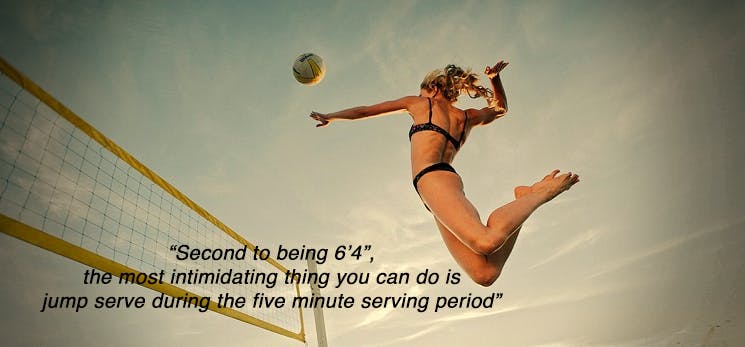Featured courses
- Volleyball Passing Drills to Win More Matches by Jackson Chlebowy
- Volleyball Serving Made Simple: Drills for Coaches and Athletes by Jackson Chlebowy
- Mastering the 5-1 Rotation in Volleyball: A Comprehensive Guide by Grant Young
- Master the Perfect Volleyball Approach – Jump Higher & Hit Harder by Sam DeJoseph
- Dominate the Net – 5 Must-Try Drills for Pin Hitters by Sam DeJoseph
- Three Small Group Training Drills to Improve Your Volleyball Team by Grant Young
- How to Teach Serving Volleyballs by Grant Young
- How to Make Your Volleyball Practices More Game-Like by Grant Young
- Three Volleyball Drills to Round Out Your Team’s Skills by Grant Young
- JUMP Serve into a Win by Eric Mahnke

JUMP Serve into a Win
- By Eric Mahnke
The jump serve has become a distinguishing factor between the elite and average volleyball player. Jump serves, although newer to the sport, can intimidate opponents and bring serious points to your team. Being able to consistently perform jump serves will help to set yourself apart from other players and help develop your attacking style when on the net.
There are two types of jump serves: The top spin jump serve and the floating jump serve. Learning both of these techniques explained in this article will help you in becoming a more versatile competitor.
The Top Spin Jump Serve
The top spin jump serve should be the first jump serve that you try to master. The technique for performing this serve is closer to the attacking technique that you use on the net, and will set the foundation for the other type of jump serve – the floater. The cons to using this type of jump serve are that your serve will be more predictable to your opponents and harder for you to control. Pros to this type of serve are that your serves will have a noticeable topspin, have more power and be harder for your opponents to pass.
The technique:
1. Setting up for your jump serve should be like attacking. Give yourself enough room to do your left-right-left (right-left-right if you are left handed) approach between you and the serving line. My serving ritual included standing on the serving line and actually stepping my approach to find where I needed to start.
2. Assume your approach position, with your feet shoulder with apart, dominate foot slightly in front and hold the ball in front of you. You can either hold it with one or two hands. Two hands will give you more control. Toss the ball 12-15 up, at an angle that will let it fall in front of you when you do your jump approach. Try tossing it up, wait for the ball to hit its peak, then do your approach and catch it in the air to find where you need the toss.
3. Once you have found your rhythm with the toss you should try full out serves. Set up, toss, approach, jump (left-right-left, arms swung back then forward to propel you up), arms lifted, attacking hand pulled back by your ear, eye contact with ball, swing. You should make contact with the ball at about arm’s length above in front of you, making sure to follow though and flick the wrist to add topspin.
The Floating Jump Serve
Personally, I find the floating jump serve to be easier to control, and more damaging to the other team on the court. Since you don’t have the long, drawn-out approach that the top spin serve requires, you can confuse the opposing team with your quick, powerful movements. It is also harder to read your serve. Your movements are quicker, and the ball itself will move either left, right or down midair, making it harder to be received by the opposing team.
The technique:
1. You will not need the same amount of space to do your approach for this serve. Repeat the first step of a top spin serve, but with a shorter, quick step approach (this can equate to about half the length of your full length approach).
2. With this jump serve, you will toss the ball with only one hand. Hold the ball out in front of you in your non-dominant hand. Keep your feet shoulder length apart, with your DOMINANT foot in front (This is the quick step approach).
3. Step left foot forward as you toss the ball two feet above, and slightly in front of, your head. Right leg will have to quickly follow as you assume your pre-jump squat. Jump up and attack ball. Make your contact slightly above and in front of your head. With this attack you do not have to make a full follow-through swing (that will make it float more), but flicking your wrist and following through will give it a slight top spin giving you an almost hybrid jump serve. It is also important that you have a strong core, as using your core strength will add power to the serve.
Second to being 6’4”, the most intimidating thing you can do is jump serve during the five minute serving period pre-game. It is important that you master the top spin jump serve before attempting the floater serve in order to have a good basic foundation. The floater jump serve is more relaxed, and will allow for more personalization – allowing for you to develop your own personal serving technique that works best for you.
Check out more serving courses on CoachTube:


